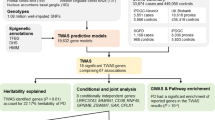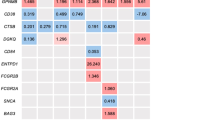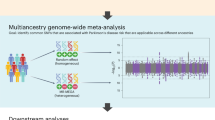Abstract
Parkinson’s disease (PD) is a common, disabling neurodegenerative disorder with significant genetic underpinnings. Multiple genome-wide association studies (GWAS) have been conducted with identification of several PD loci. However, these only explain about 25% of PD genetic risk indicating that additional loci of modest effect remain to be discovered. Association clustering methods such as gene-based tests are more powerful than single-variant analysis for identifying modest genetic effects. Combined with the locus-based algorithm, OASIS, the most significant association signals can be homed in. Here, two dbGAP GWAS datasets (7415 subjects (2750 PD and 4845 controls) genotyped for 0.78 million SNPs) were analyzed using combined clustering algorithms to identify 88 PD candidate genes in 24 loci. These were further investigated for gene expression in substantia nigra (SN) of PD and control subjects on GEO datasets. Expression differences were also assessed in normal brains SN versus white matter on BRAINEAC datasets. This genetic and functional analysis identified AXIN1, a key regulator of Wnt/β-catenin signaling, as a novel PD gene. This finding links PD with inflammation. Other significantly associated genes were CSMD1, CLDN1, ZNF141, ZNF721, RHOT2, RICTOR, KANSL1, and ARHGAP27. Novel PD genes were identified using genomic convergence of gene-wide and locus-based tests and expression studies on archived datasets.


Similar content being viewed by others
References
Aoki T, Ueda S, Kataoka T, Satoh T (2009) Regulation of mitotic spindle formation by the RhoA guanine nucleotide exchange factor ARHGEF10. BMC Cell Biol 10:56
Chang D, Nalls MA, Hallgrímsdóttir IB, Hunkapiller J, van der Brug M, Cai F, International Parkinson’s Disease Genomics Consortium; 23andMe Research Team et al (2017) A meta-analysis of genome-wide association studies identifies 17 new Parkinson’s disease risk loci. Nat Genet 49(10):1511–1516
Clevers H, Nusse R (2012) (2012). Wnt/β-catenin signaling and disease. Cell 149(6):1192–1205
Deng HX, Shi Y, Yang Y, Ahmeti KB, Miller N, Huang C, Cheng L, Zhai H, Deng S, Nuytemans K, Corbett NJ, Kim MJ, Deng H, Tang B, Yang Z, Xu Y, Chan P, Huang B, Gao XP, Song Z, Liu Z, Fecto F, Siddique N, Foroud T, Jankovic J, Ghetti B, Nicholson DA, Krainc D, Melen O, Vance JM, Pericak-Vance MA, Ma YC, Rajput AH, Siddique T (2016). Identification of TMEM230 mutations in familial Parkinson’s disease. Nat Genet 48(7):733–739.PMID: 27270108
Hernandez DG, Reed X, Singleton AB. (2016). Genetics in Parkinson disease: Mendelian versus non-Mendelian inheritance. J Neurochem 139 Suppl 1:59–74. PMID: 27090875
Horng S, Therattil A, Moyon S, Gordon A, Kim K, Argaw AT, Hara Y, Mariani JN, Sawai S, Flodby P, Crandall ED, Borok Z, Sofroniew MV, Chapouly C, John GR (2017) Astrocytic tight junctions control inflammatory CNS lesion pathogenesis. J Clin Invest 127(8):3136–3151
Hsieh CL, Lin CL, Liu H, Chang YJ, Shih CJ, Zhong CZ, Lee SC, Tan BC (2011) WDHD1 modulates the post-transcriptional step of the centromeric silencing pathway. Nucleic Acids Res 39(10):4048–4062
Huang SM, Mishina YM, Liu S, Cheung A, Stegmeier F, Michaud GA, Charlat O, Wiellette E, Zhang Y, Wiessner S et al (2009) Tankyrase inhibition stabilizes axin and antagonizes Wnt signalling. Nature 461(7264):614–620
Keller MF, Saad M, Bras J, Bettella F, Nicolaou N, Simón-Sánchez J, Mittag F, Büchel F, Sharma M, Gibbs JR, Schulte C, Moskvina V, Durr A, Holmans P, Kilarski LL, Guerreiro R, Hernandez DG, Brice A, Ylikotila P, Stefánsson H, Majamaa K, Morris HR, Williams N, Gasser T, Heutink P, Wood NW, Hardy J, Martinez M, Singleton AB, Nalls MA, International Parkinson's Disease Genomics Consortium (IPDGC), Wellcome Trust Case Control Consortium 2 (WTCCC2) (2012) Using genome-wide complex trait analysis to quantify ‘missing heritability’ in Parkinson’s disease. Hum Mol Genet 21(22):4996–5009
Kraus DM, Elliott GS, Chute H, Horan T, Pfenninger KH, Sanford SD, Foster S, Scully S, Welcher AA, Holers VM (2006) CSMD1 is a novel multiple domain complement-regulatory protein highly expressed in the central nervous system and epithelial tissues. J Immunol 176(7):4419–4430
L’Episcopo F, Tirolo C, Testa N, Caniglia S, Morale MC, Serapide MF, Pluchino S, Marchetti B (2014) Wnt/β-catenin signaling is required to rescue midbrain dopaminergic progenitors and promote neurorepair in ageing mouse model of Parkinson’s disease. Stem Cells 32(8):2147–2163
Larsen CP, Beggs ML, Saeed M, Walker PD (2013) Apolipoprotein L1 risk variants associate with systemic lupus erythematosus-associated collapsing glomerulopathy. J Am Soc Nephrol 24(5):722–725
Li MX, Sham PC, Cherny SS, Song YQ (2010) A knowledge-based weighting framework to boost the power of genome-wide association studies. PLoS One 5:e14480
Lill CM, Roehr JT, McQueen MB, Kavvoura FK, Bagade S, Schjeide BM, Schjeide LM, Meissner E, Zauft U, Allen NC, et al. (2012). Comprehensive research synopsis and systematic meta-analyses in Parkinson’s disease genetics: the PDGene database. PLoS Genet 8(3):e1002548. PMID: 22438815
Maraganore DM, de Andrade M, Lesnick TG, Strain KJ, Farrer MJ, Rocca WA, Pant PV, Frazer KA, Cox DR, Ballinger DG (2005) High-resolution whole-genome association study of Parkinson disease. Am J Hum Genet 77(5):685–693
Meunier S, Shvedunova M, Van Nguyen N, Avila L, Vernos I, Akhtar A (2015) An epigenetic regulator emerges as microtubule minus-end binding and stabilizing factor in mitosis. Nat Commun 6:7889
Misztal K, Wisniewska MB, Ambrozkiewicz M, Nagalski A, Kuznicki J (2011) WNT protein-independent constitutive nuclear localization of beta-catenin protein and its low degradation rate in thalamic neurons. J Biol Chem 286(36):31781–31788
Murata H, Sakaguchi M, Jin Y, Sakaguchi Y, Futami J, Yamada H, Kataoka K, Huh NH (2011) A new cytosolic pathway from a Parkinson disease-associated kinase, BRPK/PINK1: activation of AKT via mTORC2. J Biol Chem 286(9):7182–7189
Nagle MW, Latourelle JC, Labadorf A, Dumitriu A, Hadzi TC, Beach TG, Myers RH (2016) The 4p16.3 Parkinson disease risk locus is associated with GAK expression and genes involved with the synaptic vesicle membrane. PLoS One 11(8):e0160925
Nakamura T, Hamada F, Ishidate T, Anai K, Kawahara K, Toyoshima K, Akiyama T (1998) Axin, an inhibitor of the Wnt signalling pathway, interacts with beta-catenin, GSK-3beta and APC and reduces the beta-catenin level. Genes Cells 3(6):395–403
Pankratz N, Wilk JB, Latourelle JC, AL DS, Halter C, Pugh EW, Doheny KF, Gusella JF, Nichols WC, Foroud T, Myers RH, PSG-PROGENI and GenePD Investigators, Coordinators and Molecular Genetic Laboratories (2009) Genomewide association study for susceptibility genes contributing to familial Parkinson disease. Hum Genet 124(6):593–605
Ruiz-Martínez J, Azcona LJ, Bergareche A, Martí-Massó JF, Paisán-Ruiz C (2017) Whole-exome sequencing associates novel CSMD1 gene mutations with familial Parkinson disease. Neurol Genet 3(5):e177
Saeed M (2017) Novel linkage disequilibrium clustering algorithm identifies new lupus genes on meta-analysis of GWAS datasets. Immunogenetics 69:295–302
Saeed M (2018) Locus and gene-based GWAS meta-analysis identifies new diabetic nephropathy genes. Immunogenetics 70(6):347–353
Sakakibara T, Nemoto Y, Nukiwa T, Takeshima H (2004) Identification and characterization of a novel rho GTPase activating protein implicated in receptor-mediated endocytosis. FEBS Lett 566(1–3):294–300
Sampson TR, Debelius JW, Thron T, Janssen S, Shastri GG, Ilhan ZE, Challis C, Schretter CE, Rocha S, Gradinaru V, Chesselet MF, Keshavarzian A, Shannon KM, Krajmalnik-Brown R, Wittung-Stafshede P, Knight R, Mazmanian SK (2016) Gut microbiota regulate motor deficits and neuroinflammation in a model of Parkinson’s disease. Cell 167(6):1469–1480.e12
Simón-Sánchez J, Schulte C, Bras JM, Sharma M, Gibbs JR, Berg D, Paisan-Ruiz C, Lichtner P, Scholz SW, Hernandez DG, Krüger R, Federoff M, Klein C, Goate A, Perlmutter J, Bonin M, Nalls MA, Illig T, Gieger C, Houlden H, Steffens M, Okun MS, Racette BA, Cookson MR, Foote KD, Fernandez HH, Traynor BJ, Schreiber S, Arepalli S, Zonozi R, Gwinn K, van der Brug M, Lopez G, Chanock SJ, Schatzkin A, Park Y, Hollenbeck A, Gao J, Huang X, Wood NW, Lorenz D, Deuschl G, Chen H, Riess O, Hardy JA, Singleton AB, Gasser T (2009) Genome-wide association study reveals genetic risk underlying Parkinson’s disease. Nat Genet 41(12):1308–1312
Verhoeven K, De Jonghe P, Van de Putte T, Nelis E, Zwijsen A, Verpoorten N, De Vriendt E, Jacobs A, Van Gerwen V et al (2003) Slowed conduction and thin myelination of peripheral nerves associated with mutant rho guanine-nucleotide exchange factor 10. Am J Hum Genet 73(4):926–932
Wang X, Winter D, Ashrafi G, Schlehe J, Wong YL, Selkoe D, Rice S, Steen J, LaVoie MJ, Schwarz TL (2011) PINK1 and Parkin target Miro for phosphorylation and degradation to arrest mitochondrial motility. Cell 147(4):893–906
Weihofen A, Thomas KJ, Ostaszewski BL, Cookson MR, Selkoe DJ (2009) Pink1 forms a multiprotein complex with Miro and Milton, linking Pink1 function to mitochondrial trafficking. Biochemistry 48(9):2045–2052
Zollino M, Orteschi D, Murdolo M, Lattante S, Battaglia D, Stefanini C, Mercuri E, Chiurazzi P, Neri G, Marangi G (2012) Mutations in KANSL1 cause the 17q21.31 microdeletion syndrome phenotype. Nat Genet 44(6):636–638
Acknowledgements
All GWAS data was obtained from dbGAP.
Web links
OASIS [https://github.com/dr-saeed/OASIS/blob/master/OASIS.py], SNIPPER [https://csg.sph.umich.edu/boehnke/snipper], KGG [http://grass.cgs.hku.hk/limx/kgg], BRAINEAC [http://www.braineac.org] and STRING [https://string-db.org/cgi/input.pl], LDlink [https://analysistools.nci.nih.gov/LDlink/?tab=ldmatrix]
Author information
Authors and Affiliations
Corresponding author
Ethics declarations
Conflict of Interest
The author declares that he has no conflicts of interest.
Electronic supplementary material
ESM 1
Table S1. OASIS identified PD loci in two GWAS datasets, shows the 24 replicated PD loci and their candidate genes in the two datasets (db1, db2). Data regarding the chromosomal location and the strength of the association signal (−log (P), OASIS scores and Quadrants [A, B or C]) is shown. The genes shown are based on their significant association in GATES analysis at the respective locus. Table S2: SNIPPER derived candidate genes in 24 OASIS loci, Lists the 379 genes located in the 24 OASIS loci that overlapped in db1 and db2. Table S3. Gene-wide associations of OASIS identified PD loci in db1, Shows the genes that were significantly associated in db1 (sporadic PD) on GATES analysis. PBH indicate the Benjamini & Hochberg (BH) correction P-value. Table S4. Gene-wide associations of OASIS identified PD loci in db2, Shows the genes that were significantly associated in db2 (familial PD) on GATES analysis. Table S5. Single-variant replication of OASIS identified PD loci in three datasets, Shows the single variant replication statistics of SNPs with the highest −log [P] values (Max_SNP) in OASIS identified loci in db3, db4 and db5. Gene name and location is according to PDGene (db4). (XLSX 45 kb). Table S6 BRAINEAC eQTL analysis of significant SNPs at locus 22 containing AXIN1, shows the SNPs, their genomic location, the eQTL P-value for the probe t3675047 (AXIN1), the tissue in which AXIN1 expression is significantly altered by the SNP and the db1, db2 genetic association P-values. OCXT – occipital cortex; WHMT – white matter; SNIG – substantia nigra; PUTM – putamen; THAL – thalamus; NA – data not available. (XLSX 13 kb)
ESM 2
DOCX 13 kb
ESM 2
Figure S1: OASIS quadrants, describes the OASIS quadrants A, B and C diagrammatically. The scatter graph shows −log [P] values plotted against OASIS scores for db1. Figure S2: Flow chart of the study methodology. The methods and study organization are graphically summarized in this flow chart. (PPTX 293 kb)
Rights and permissions
About this article
Cite this article
Saeed, M. Genomic convergence of locus-based GWAS meta-analysis identifies AXIN1 as a novel Parkinson’s gene. Immunogenetics 70, 563–570 (2018). https://doi.org/10.1007/s00251-018-1068-0
Received:
Accepted:
Published:
Issue Date:
DOI: https://doi.org/10.1007/s00251-018-1068-0




